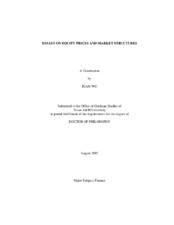| dc.description.abstract | In the first essay, we provide new evidence on the relationship between order flow and prices, an issue that is central to asset pricing and market microstructure. We examine proprietary data on a broad panel of NYSE-listed stocks that reveal daily order imbalances by institutions, individuals, and market makers. We can further differentiate regular institutional trades from institutional program trades. Our results indicate that order imbalances from different trader types play distinctly different roles in price formation. Institutions and individuals are contrarians with respect to previous-day returns but differ in the effect their order imbalances have on contemporaneous returns. Institutional imbalances are positively related to contemporaneous returns, and cross-sectional evidence suggests this relationship is likely to be the result of firm-specific information institutions have. Individuals, specialists, and other market makers appear to provide liquidity to these actively trading institutions. Our results also suggest a special role for institutional program trades. Institutions choose program trades when they have no firm-specific information and can afford to trade passively. As a result, program trades provide liquidity to the market. Finally, both institutional non-program and individual imbalances have predictive power for next-day returns. In the second essay, based on daily shorting flow data for a large sample of NYSE-listed stocks, we show that short sellers enhance the relative efficiency of transaction prices. We also provide new evidence on the recent suspension of the Uptick Rule for Regulation SHO Pilot stocks. Relative to matched control stocks, pilot stocks experience some improvement in price efficiency associated with increased shorting activity after the tick test was suspended. The third essay studies demutualization of stock exchanges. Using panel data on 132 major stock exchanges in 114 countries from 1990 to 2003, we examine the effect of demutualization on an exchange’s performance in its primary product markets: trading and listings. We document some evidence that demutualization is associated with improved competitiveness in attracting trading volume. Results on listings following demutualization are weak. | en |


